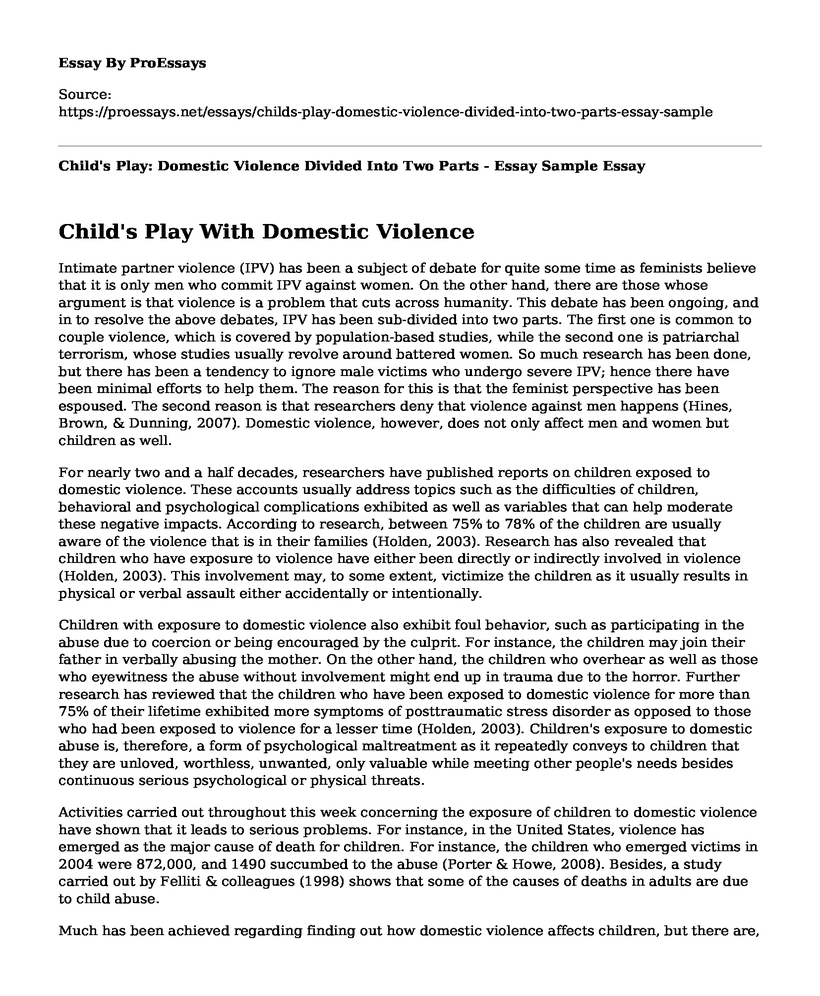Child's Play With Domestic Violence
Intimate partner violence (IPV) has been a subject of debate for quite some time as feminists believe that it is only men who commit IPV against women. On the other hand, there are those whose argument is that violence is a problem that cuts across humanity. This debate has been ongoing, and in to resolve the above debates, IPV has been sub-divided into two parts. The first one is common to couple violence, which is covered by population-based studies, while the second one is patriarchal terrorism, whose studies usually revolve around battered women. So much research has been done, but there has been a tendency to ignore male victims who undergo severe IPV; hence there have been minimal efforts to help them. The reason for this is that the feminist perspective has been espoused. The second reason is that researchers deny that violence against men happens (Hines, Brown, & Dunning, 2007). Domestic violence, however, does not only affect men and women but children as well.
For nearly two and a half decades, researchers have published reports on children exposed to domestic violence. These accounts usually address topics such as the difficulties of children, behavioral and psychological complications exhibited as well as variables that can help moderate these negative impacts. According to research, between 75% to 78% of the children are usually aware of the violence that is in their families (Holden, 2003). Research has also revealed that children who have exposure to violence have either been directly or indirectly involved in violence (Holden, 2003). This involvement may, to some extent, victimize the children as it usually results in physical or verbal assault either accidentally or intentionally.
Children with exposure to domestic violence also exhibit foul behavior, such as participating in the abuse due to coercion or being encouraged by the culprit. For instance, the children may join their father in verbally abusing the mother. On the other hand, the children who overhear as well as those who eyewitness the abuse without involvement might end up in trauma due to the horror. Further research has reviewed that the children who have been exposed to domestic violence for more than 75% of their lifetime exhibited more symptoms of posttraumatic stress disorder as opposed to those who had been exposed to violence for a lesser time (Holden, 2003). Children's exposure to domestic abuse is, therefore, a form of psychological maltreatment as it repeatedly conveys to children that they are unloved, worthless, unwanted, only valuable while meeting other people's needs besides continuous serious psychological or physical threats.
Activities carried out throughout this week concerning the exposure of children to domestic violence have shown that it leads to serious problems. For instance, in the United States, violence has emerged as the major cause of death for children. For instance, the children who emerged victims in 2004 were 872,000, and 1490 succumbed to the abuse (Porter & Howe, 2008). Besides, a study carried out by Felliti & colleagues (1998) shows that some of the causes of deaths in adults are due to child abuse.
Much has been achieved regarding finding out how domestic violence affects children, but there are, however, some gaps that need to be covered. For instance, most of the research carried out included whites. There should, therefore, be a future goal to research with diverse and larger samples (Porter & Howe, 2008). There is also a need to conduct more research in the future that is based on direct observation, as most of the research currently is based on self-reports.
References
Hines, D. A., Brown, J., & Dunning, E. (2007). Characteristics of Callers to the Domestic Abuse Helpline for Men. Journal of Family Violence, 22(2), 63-72. doi:10.1007/s10896-006-9052-0
Holden, G. W. (2003, September). Children Exposed to Domestic Violence and Child Abuse: Terminology and Taxonomy. Retrieved February 7, 2020, from https://link.springer.com/article/10.1023/A:1024906315255
Porter, B., & Howe, T. (2008). Pilot Evaluation of the "ACT Parents Raising Safe Kids" Violence Prevention Program. Journal of Child & Adolescent Trauma, 1(3), 193-206. doi:10.1080/19361520802279158
Cite this page
Child's Play: Domestic Violence Divided Into Two Parts - Essay Sample. (2023, Apr 01). Retrieved from https://proessays.net/essays/childs-play-domestic-violence-divided-into-two-parts-essay-sample
If you are the original author of this essay and no longer wish to have it published on the ProEssays website, please click below to request its removal:
- Research Paper on Anti-Bias Education
- Social Factors Affecting Perception Essay Example
- Violence in America - Essay Sample
- Paper Example on Violence Exposure & Its Impact on Child Development
- Essay Example on Feminist Analysis of Gender Concepts: Examining the Concept of a Man
- Free Research Paper Sample on Social Exclusion of People with Mental Illness: A Global Issue
- Essay Example on Walk Our Talk: End Gender-Based Violence Against Women & Girls







